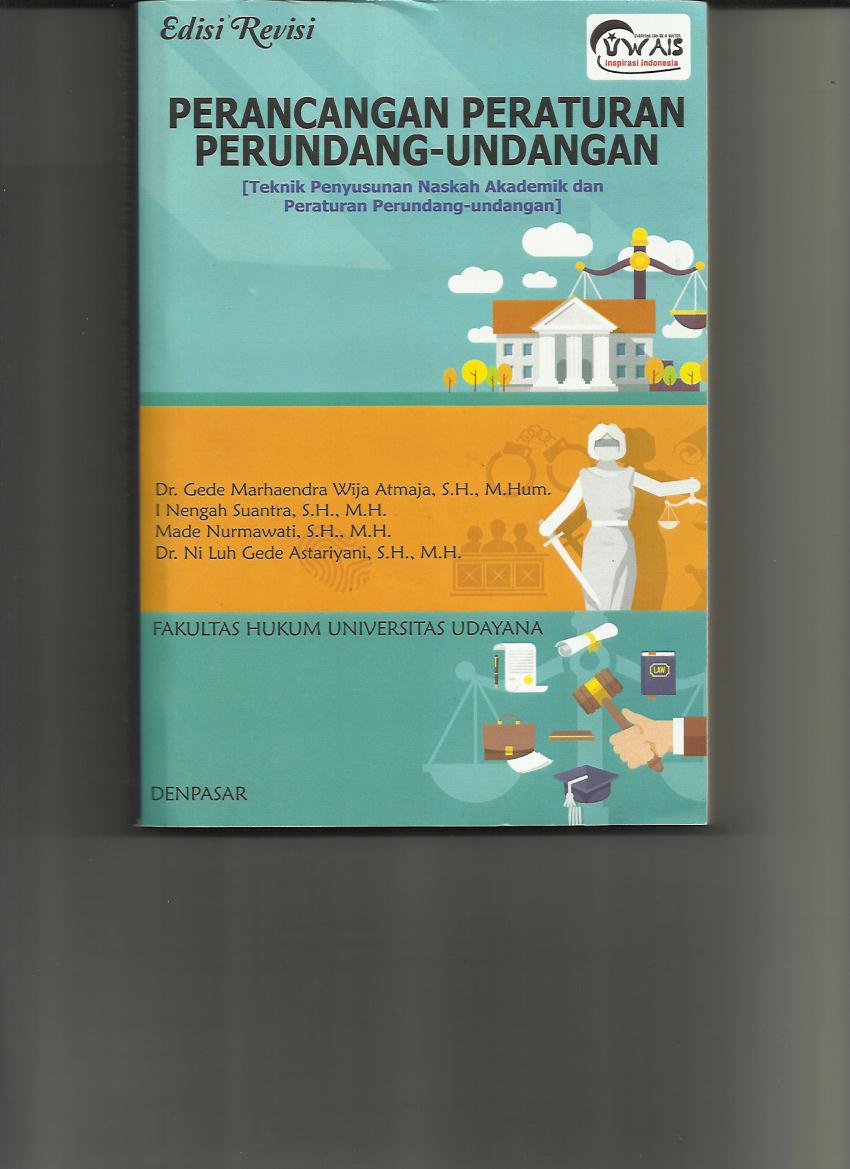
Legal Drafting [Academic Document Drafting Technique and Legislation]
Dr. Gede Marhaendra Wija Atmaja,S.H., M.Hum, I Nengah Suantra, S.H., M.H., Made Nurmawati, S.H., M.H., Dr. Ni Luh Gede Astariyani, S.H., M.H.
ISBN : 978-602-5891-04-5 Published : 2018
Abstrak
The Legal Drafting presents
material: understanding, scope and theory of the formation of laws and
regulations; preparation of academic documentts draft legislation; techniques
for drafting legislation; and techniques for drafting thematic legislation.
Understanding of some terminology related to this course, among others:
legislation techniques, techniques of drafting legislation, and forming
legislation. Understanding the draft legislation refers to the opinions of L.M.
Bakshi, van Apeldoorn, and Bagir Manan. Legislation theory put forward by J.M.
Otto, W.S.R. Stoter & J. Arnscheidt, who discussed agenda-forming theory,
elite ideology theory, bureau-political theory, and the four layers of
rationality theory and ROCCIPI legislation theory, and Regulatory Impact
Assessment (RIA) were also included in the first meeting. The study material
was carried out deepening through tutorial activities in the second and third
meetings.
The study material
regarding the academic document of the legislation, is intended to resolve problematic behavior in
society and solely for the public interest. Academic documentt study materials
include: identification of needs and alternative development; formulation of
title and systematic formulation of academic document; preparation of the introduction;
preparation of theoretical study sections and empirical practice; preparation
of the evaluation and analysis of relevant legislation; compilation of
philosophical, sociological and juridical foundation parts; compilation of part
of the scope, direction of regulation, and scope of the contents of laws,
provincial regional regulations, or district / city regional regulations;
preparation of the closing section; and compilation of bibliography and
alignment of the Academic documentt format. Academic Writing is done through
tutorial activities in the fifth and sixth meetings.
After completing
the Academic document activities, the next material is about the techniques of drafting
legislation and various terms for mentioning - naming the legal framework,
among others: framework, composition, systematic, external form, or format of
legislation, and the general structure of laws and regulations. The regulatory
framework consists of: Title, Preamble, Body, Cover, Explanation (if needed),
and Attachment (if needed). Next, provisions regarding the techniques for
preparing titles include: types of laws and regulations; statutory regulation
number; year of promulgation or enactment of laws and regulations; and the name
of the legislation. The preparation of the opening part consists of phrases
with the grace of God Almighty; position in forming legislations;
considerations; Legal Basis; and dictum. The techniques for preparing the Body
include the technique for formulating general provisions, subject matter that
is regulated, criminal provisions (if needed), transitional provisions (if
needed), and closing provisions. The concluding section contains material
regarding the promulgation and placement in the State Gazette of the Republic
of Indonesia, State Gazette of the Republic of Indonesia, Regional Gazette and
Regional News, signing of legalization or enactment of laws and regulations,
promulgation or stipulation of legislation, and the end of the concluding
section. The preparation of the Title, Opening, Torso, Closing, Explanation and
Attachment of the legislation is done at the tutorial activities in the ninth,
tenth, and eleventh meetings.
Presentation of
materials for the study of the preparation of thematic laws and regulations was
carried out in the next meeting. Here is an understanding of the drafting of
legislation regarding changes in legislation, the drafting of legislation
concerning the revocation of legislation, the drafting of laws concerning the
stipulation of government regulations to replace laws into law, and the
drafting of regulations legislation regarding the ratification of treaties or
international agreements. The techniques for preparing thematic laws and
regulations are basically the same that, in the name section of these laws and
regulations, specific information is given regarding changes, revocation,
stipulation or endorsement as needed. In this case there are technical
differences. In the body of the statutory changes, the article is given a
number using roman numerals. While the body of the legislation revokes the
legislation, the enactment of the Perpu, and the ratification of the
international agreement the body uses a number with Arabic numerals. The
preparation of the thematic laws and regulations was carried out at the
tutorial activity in the last meeting.
